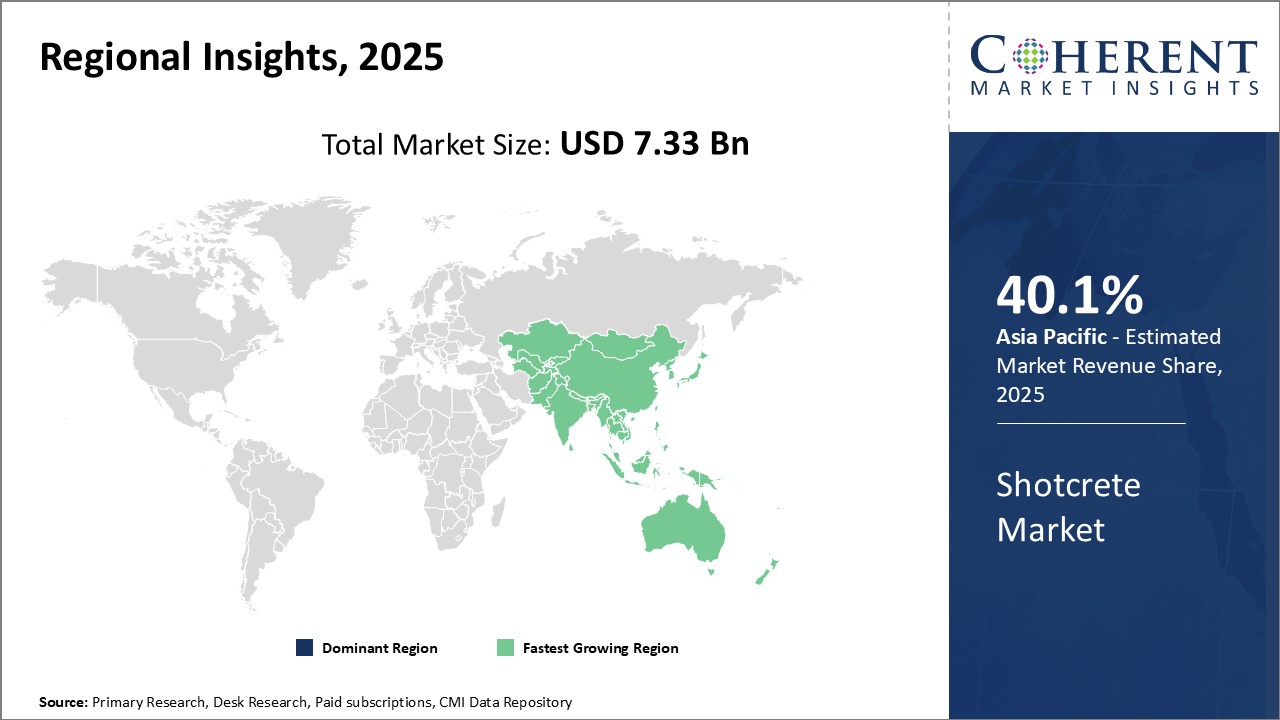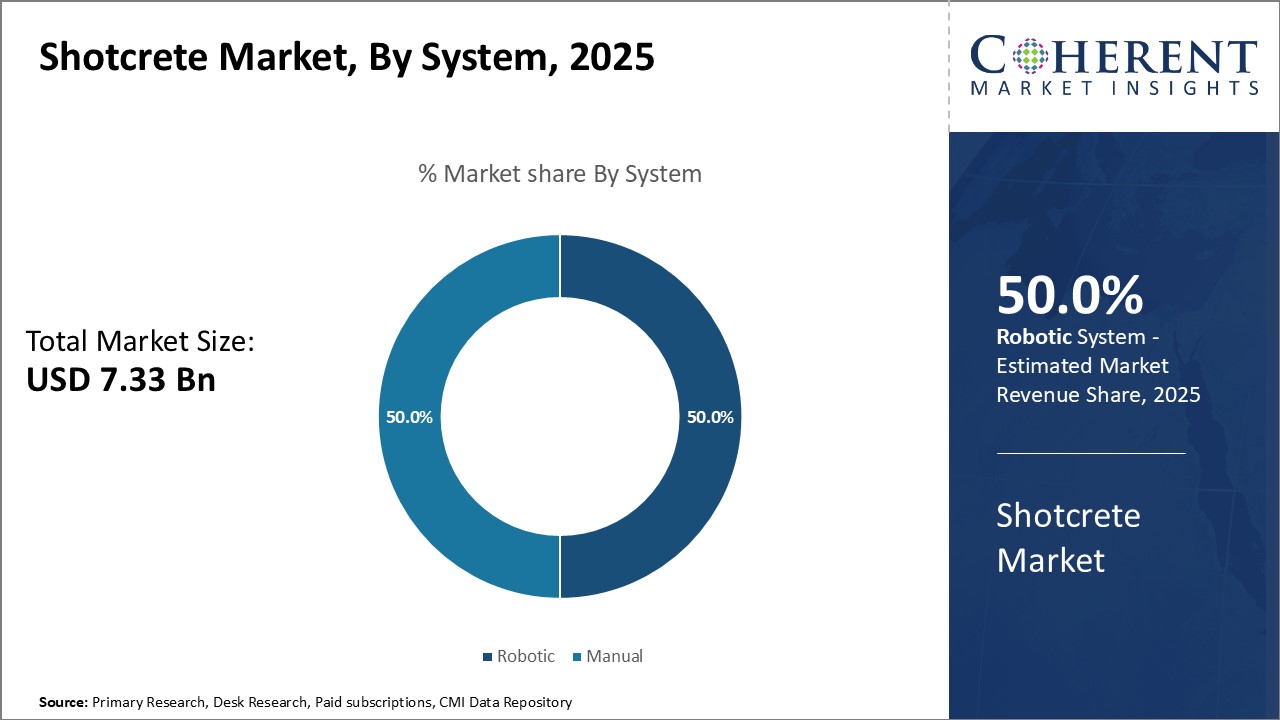The Shotcrete Market size is valued at US$ 7.33 Bn in 2025 and is expected to reach US$ 11.85 Bn by 2032, growing at a compound annual growth rate (CAGR) of 7.1% from 2025 to 2032. Shotcrete is a technique used to pneumatically spray concrete through a hose at high velocity onto the surface. Factors such as growing underground construction activities including tunneling and mining activities and rampant growth in infrastructure development are factors expected to boost the growth of the shotcrete market during the forecast period.
Market Regional Insights:
Figure 1. Shotcrete Market Share (%), By Region, 2025

To learn more about this report, Download Free Sample
Analyst’s Views:
The market continues to grow steadily driven by increasing infrastructure development activities worldwide. Rising investments in road construction, tunnels, and other infrastructure projects especially in developing nations of Asia Pacific and Latin America are boosting the demand for Shotcrete. The easy and quick application properties of Shotcrete make it a preferred construction material for repair and rehabilitation of structures. Shotcrete reduces the construction time significantly compared to conventional concrete construction methods. However, the availability of substitutes and fluctuating raw material prices pose challenges to market growth. Concrete pumping and other modern construction techniques provide alternatives to Shotcrete for infrastructure construction. Moreover, volatility in prices of cement and other raw materials increases the input costs for Shotcrete manufacturers. Stringent environmental norms pertaining to concrete dust emissions during Shotcrete spraying also act as a restraint.
Going forward, the increasing adoption of fiber reinforced Shotcrete and the development of innovative formulations present promising opportunities. The market players are focusing on expanding their product portfolios with advanced fiber reinforced variants with higher strength and durability. The Asia Pacific region, led by China, India, and other developing economies, dominates the market currently due to massive infrastructure growth. North America and Europe are also sizable markets driven by renovation activities of aging structures in these regions.
Market Drivers:
Increasing construction activities: The construction industry has seen considerable growth in recent years with increasing infrastructure development activities around the world. This rise in construction operations has directly benefited the shotcrete market as well. Shotcrete, also known as sprayed concrete, is a technique widely used in construction where concrete is pneumatically projected at high velocity onto a surface, such as rock or soil, to form reinforced or unreinforced structural layers.
Various infrastructure projects involving tunnels, underground excavations, slope stabilization works, and repairing of deteriorated concrete structures have highly relied on shotcrete applications. For instance, according to the 2020 data from the United Nations, the total investment in sustainable infrastructure development across nations increased from US$1 Bn in 2020 to US$1.4 Bn in 2022. This includes major investments in transportation, sanitation, energy, and housing projects which extensively employ shotcrete for its advantages such as speed of application in difficult terrains, accuracy in covering large surface areas, and bonding strength.
Rising commercial and public infrastructure projects: Rising commercial and public infrastructure projects are fueling the growth of the market. Shotcrete, also known as sprayed concrete, is increasingly utilized in various construction applications due its versatility and cost effectiveness. The material can be smoothly applied on extensive surface areas in both vertical and horizontal orientations which has helped speed up the construction process.
Many countries worldwide have undertaken ambitious infrastructure development plans and projects in recent years. For example, the Indian government has allocated over US$1.5 Bn for infrastructure development between 2020 and 2023 according to India’s Ministry of Statistics and Program Implementation. This includes efforts towards expanding and modernizing the national highway network, developing new smart cities and urban infrastructure, upgrading the railway systems, constructing more airports, building new townships, and improving water supply and sanitation facilities across the country. Similarly, countries in Southeast Asia, Latin America, Middle East, and Africa have also devoted large public investments towards boosting critical infrastructure like roads, bridges, dams, tunnels, mass transit systems, and utility networks.
Technological advancements in Shotcrete machines and equipment: Technological advancements in Shotcrete machinery and equipment have significantly helped in driving the growth of the market in recent years. Various new methods and process improvements have emerged that allow for faster application of shotcrete. For instance, robotic Shotcrete applications allow for the uniform coverage of large surface areas in a more consistent and controlled manner compared to manual spraying. This has helped increase productivity and quality especially for large infrastructure projects. Furthermore, the development of lighter and more powerful pumps has made it possible to spray shotcrete over greater heights and difficult terrains more efficiently.
Market Opportunities:
Shotcrete Market Report Coverage
| Report Coverage | Details | ||
|---|---|---|---|
| Base Year: | 2024 | Market Size in 2025: | USD 7.33 Bn |
| Historical Data for: | 2020 To 2024 | Forecast Period: | 2025 To 2032 |
| Forecast Period 2025 to 2032 CAGR: | 7.1% | 2032 Value Projection: | USD 11.85 Bn |
| Geographies covered: |
|
||
| Segments covered: |
|
||
| Companies covered: |
BASF SE, Heidelberg Cement, Grupo ACS, Lafargeholcim, Cemex, Sika AG, GCP Applied Technologies, U.S. Concrete, Mapei, and Normet |
||
| Growth Drivers: |
|
||
| Restraints & Challenges: |
|
||
Uncover macros and micros vetted on 75+ parameters: Get instant access to report
Global Shotcrete Market Trends:
Global Shotcrete Market Restraints:
Figure 2. Shotcrete Market Share (%), By System, 2025

To learn more about this report, Download Free Sample
Recent Developments:
Top Companies in the Shotcrete Market
Definition: Shotcrete, also known as gunite or sprayed concrete, is a construction material that is conveyed through a hose and pneumatically projected at high velocity onto a surface. It is usually an all-inclusive term for both the wet-mix and dry-mix versions and can be sprayed onto any type or shape of surface, including vertical or overhead areas. Shotcrete is commonly used to line tunnel walls, in mines, subways, and automobile tunnels, and it is known for its high compressive strength, durability, water tightness, and frost resistance. It is a versatile material that can be used for a variety of applications, including reinforcing both temporary and permanent excavations, as well as in the construction of artificial rock walls, zoo enclosures, canopy roofs, pools, and dams.
Share
Share
About Author
Yash Doshi is a Senior Management Consultant. He has 12+ years of experience in conducting research and handling consulting projects across verticals in APAC, EMEA, and the Americas.
He brings strong acumen in helping chemical companies navigate complex challenges and identify growth opportunities. He has deep expertise across the chemicals value chain, including commodity, specialty and fine chemicals, plastics and polymers, and petrochemicals. Yash is a sought-after speaker at industry conferences and contributes to various publications on topics related commodity, specialty and fine chemicals, plastics and polymers, and petrochemicals.
Missing comfort of reading report in your local language? Find your preferred language :
Transform your Strategy with Exclusive Trending Reports :
Frequently Asked Questions
Select a License Type
Joining thousands of companies around the world committed to making the Excellent Business Solutions.
View All Our Clients